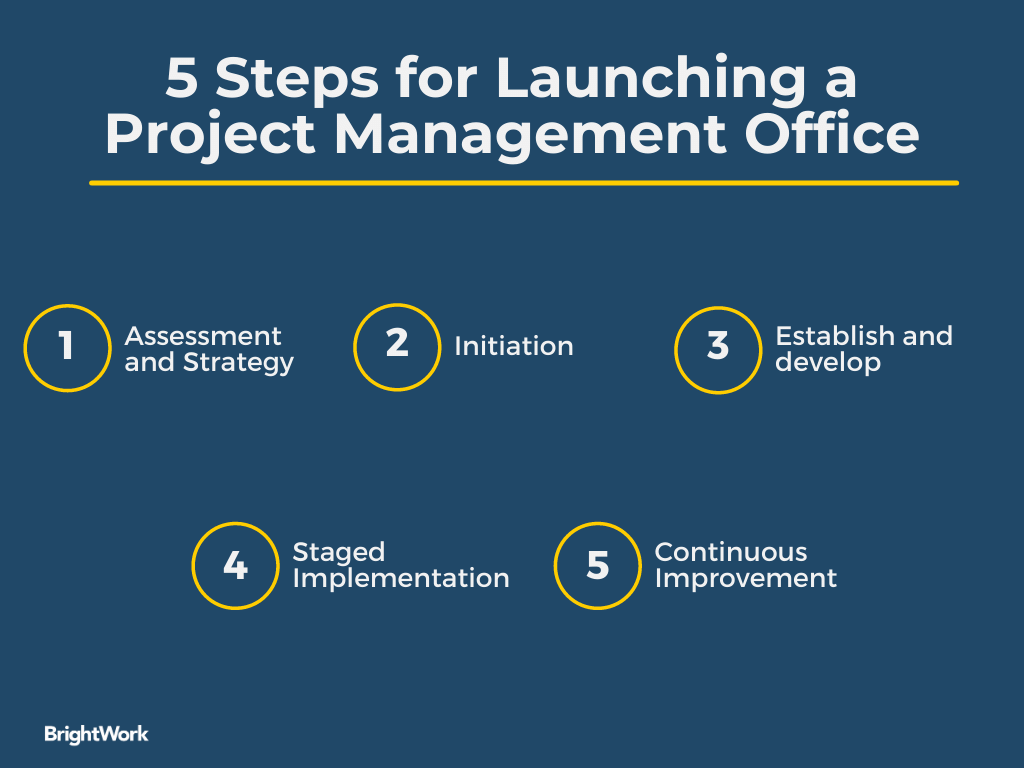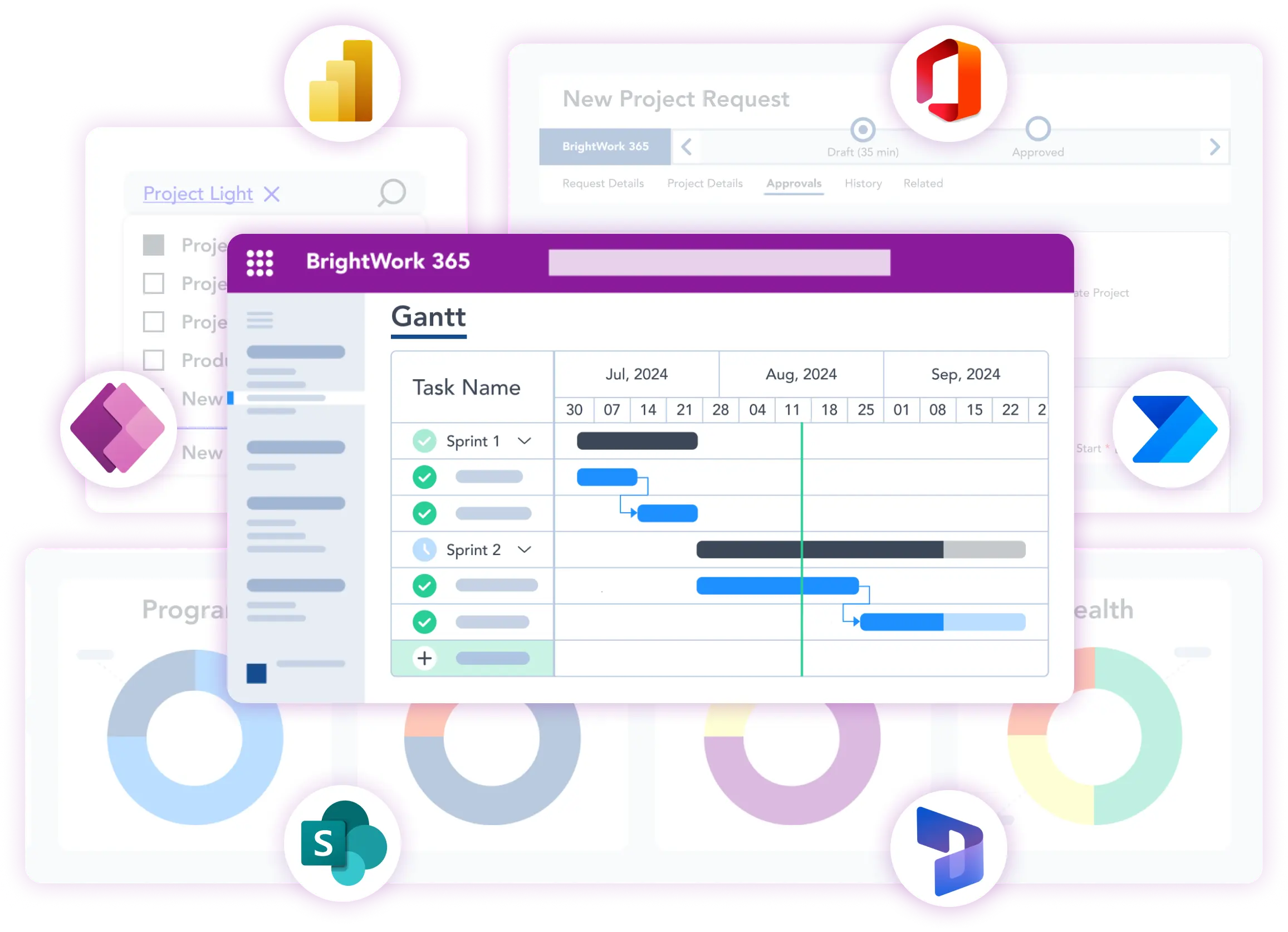A Project Management Office (PMO) is typically responsible for designing and implementing a standardized approach to project management within an organization.
Find Full Guide: How to build a high-performing PMO
Working in tandem with project and portfolio management goals, the PMO helps organizations to realize significant business value from successful projects.
Whilst no two PMOs are the same, we have put together a series of articles outlining a five-step process to help you launch your PMO.
In this article, we’ll take a brief look at the five steps before delving into the first stage, Assessment and Strategy, in more detail.
5 Steps for Launching a Project Management Office
The recommended five-step approach for setting up a PMO runs as follows:
- Assessment and Strategy – a review of your current situation and goals.
- The initiation of the PMO, including developing the scope of the PMO and a roadmap.
- Establish and develop your PMO with the right resources and processes.
- Implement the plan in stages by moving selected projects into the PMO.
- Seek opportunities for continuous improvement and feedback.

Let’s start with the first step, PMO Assessment and Strategy.
4 Key Steps for PMO Assessment and Strategy
PMO Assessment and Strategy is further broken into four sub-steps.
1. Assess the current status of project and portfolio management
Before you can establish the PMO, you need to figure out the current state of project management in your organization.
You need to understand what projects are in-flight and how these projects are running, upcoming projects, and how projects are managed across departments.
Look for data on budget, duration, delays, risks, and business value.
It’s also helpful to understand obstacles to project success, such as a lack of templates or poor training.
There are a few ways to gather the information:
- Use a survey or interview project managers and stakeholders.
- Review lessons learned (if available) to understand issues and successes from previous projects.
- Pull metric-based reports from any project management software or tools in use.
During this phase, identify and engage a project sponsor who shares your vision. Having this support early on will make it easier to overcome challenges in later phases.
The project sponsor should be committed to this project for the long term and be willing to advocate on your behalf as needed.
2. Develop desired future state
Once you have assessed your current state, decide what the organization needs from a PMO.
The goals will depend on organizational strategy and can include:
- Creating a common approach to project and portfolio management.
- Improving project outcomes with new software, templates, and training.
- Increasing project success rates by a certain percentage year on year.
- Delivering more business value with closer alignment between projects and strategy.
You’ll also need to reflect on the framework for the PMO.
A PMO can span the entire organization or be associated with a particular project or department.
The PMO may take on a Supportive, Controlling, or Directive role.
- Supportive: The PMO provides support such as training and templates. This works well in organizations that are already delivering successful projects and require a light level of control.
- Controlling: The PMO assigns and implements processes, procedures, and documentation to standardize projects.
- Directive: In this instance, the PMO takes direct control of projects.
Find more about the different types of PMOs and how to choose the one for your business.
Develop the desired future state – and document it.
3. Perform gap analysis between current and future states
Having completed Steps 1 and 2, move into strategy.
During this phase, carry out a gap analysis between the current and desired future states. This will help you to identify where you are now, where you want to be, and how you are going to get there.
This analysis will direct what processes you need to introduce to your organization and surface “quick wins” that will energize the team and bolster your efforts.
This step will help you to determine the required budget, technology, and resources needed.
4. Gain approval to proceed to the next phase
Finally, share your ideas with the project sponsor for approval and move to the next step – PMO Initiation.
Launching a Project Management Office
This article is part of a four-part series, which looks at how to establish a successful PMO. If you want to jump to another part of the process, just follow the links below:
- Launching a Project Management Office: Initiation
- Launching a Project Management Office: Establish and Evolve
- Launching a Project Management Office: Implementation and Improvement
Editor’s Note: This post was originally published in October 2015 and has been updated for freshness, accuracy, and comprehensiveness.
Setting up a centralized PMO with Microsoft 365
BrightWork 365 leverages Microsoft 365, Power Platform, and Teams to enable PMOs with a centralized project management system.

